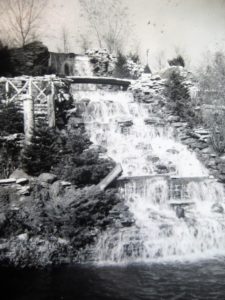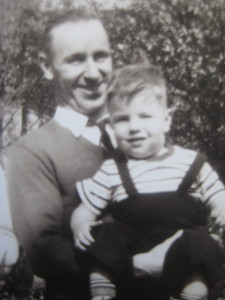When I was a little tyke, my mom would take me on the bus, during a hot summer’s day, up Diversey avenue to Pulaski Road to spend an hour or two at the Olson Rug Company Waterfall.
So indelible on my mind, the waterfall, built by company workers during the Great Depression, drew me later on as a twelve year old, to bike my way to a place where my fantasies could wander as I daydreamed about pirates and Indians (the falls had totem poles and full sized carved statues of Native Americans in full dress); coves and caves greeting me as I wound my way along paths of Birch wood railings and bridges.
Along with the rock gardens fenced with stones retrieved from the Chicago Fire, the Olson Waterfall held an attraction for me that has never been duplicated. It was my quite place, a refuge from the confusing years of pre-teen and early teen angst. It was a beautiful spot to reflect which I often visited, and I wasn’t alone.
I would ride up the sidewalk, lock my bike in the rack provided and walk down along side the factory passing a popcorn machine, whirligig man, pop and ice cream wagons and an array of sidewalk tables and chairs until I came to the main attraction: the waterfall.
It was a day in the park. Employees from surrounding factories and businesses sat on the edge of the grass eating their lunch; kids, like me, running and walking along the paths, up and over the falls while shouts of “popcorn” and the cries of babies carried in the breeze, mixing with the quiet, soothing sound of water rushing over the rocks and into the pools and coves below.
Many times I climbed to the top of the falls, stood on the birch wood bridge and peered over into the pools below, catching the glitter of pennies, a few nickels and dimes, and wondered if I could grab a handful without being caught. I never attempted the deed realizing these coins represented the wishes of others. I tossed a penny or two although have forgotten what was wished for, or whether the wish was granted, but it doesn’t matter because, as a kid, it was the dream, the hope that was instilled in your heart when the coin was tossed.
Occasionally I would wander over to the side of the falls and peer into the little hidden cove in the rocks, where deep-blue painted cement at the bottom gave the water an idyllic tropical color. I thought about rolling up my pants and wading inside to find a secret passage to hidden pirate treasure but again, never fulfilled my whim, afraid of being discovered and barred forever from my Land of Imagination.
Even in the winter, especially during the Christmas holiday season, The Falls and expansive front yard were transformed into a wonderland for kids as Olson would decorate the entire area with lights and displays. Although the water was turned off, at night the place was aglow with colored lights and a Santa who flew back and forth across the falls in his sled and reindeer. It was a mystical wonderland of lights, huge candy canes, snowmen and decorated trees providing its contribution to the Spirit of Christmas.
Sadly, the Olson waterfall is long gone, replaced by a parking lot and any evidence of what once was has been bulldozed and buried under a carpet of asphalt. Every so often I remember those times as a child when my imagination grew, my dreams were nourished and my confusion as an adolescent were temporarily given a rest as I listened to the water gently swirling in the pools of blue in a little oasis of plain old escapism alongside a factory on Chicago’s northwest side.

